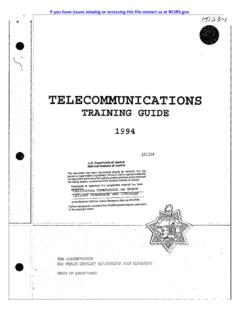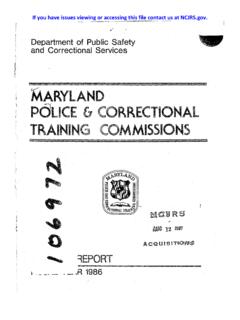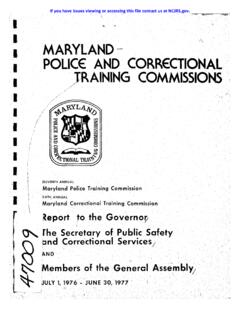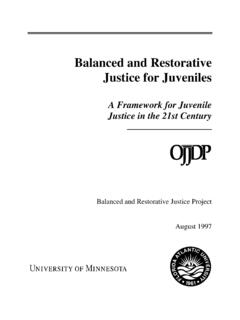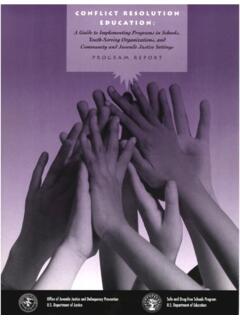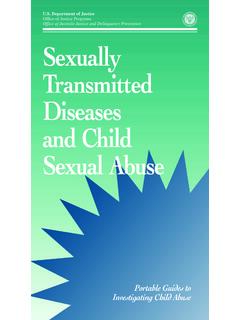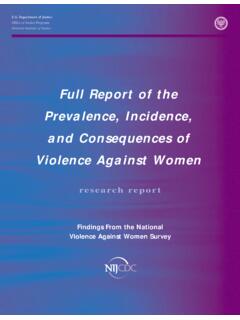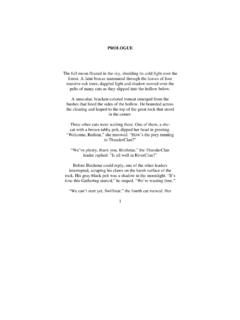Transcription of Ne Perspectives in Policing - NCJRS
1 New Perspectives in PolicingV ER ITASHARVARD Kennedy SchoolProgram in Criminal JusticePolicy and ManagementNational Institute of JusticeExecutive Session on Policing and Public SafetyThis is one in a series of papers that will be published as a result of the Executive Session on Policing and Public Safety. Harvard s Executive Sessions are a convening of individuals of independent standing who take joint responsibility for rethinking and improving society s responses to an issue. Members are selected based on their experiences, their reputation for thoughtfulness and their potential for helping to disseminate the work of the Session. In the early 1980s, an Executive Session on Policing helped resolve many law enforcement issues of the day. It produced a number of papers and concepts that revolutionized Policing .
2 Thirty years later, law enforcement has changed and NIJ and the Harvard Kennedy School are again collaborating to help resolve law enforcement issues of the day. Learn more about the Executive Session on Policing and Public Safety at: , keywords Executive Session Policing , keywords Executive Session Policing APRIL 2015 From warriors to Guardians: Recommitting American Police Culture to Democratic IdealsSue Rahr and Stephen K. Rice In Plato s vision of a perfect society in a republic that honors the core of democracy the greatest amount of power is given to those called the Guardians. Only those with the most impeccable character are chosen to bear the responsibility of protecting the democracy. 1 IntroductionBeginning in the 1960s, and more recently fueled by post 9-11 fear, American Policing has slowly drifted away from Plato s vision of guardians and Socrates view of guardian education as expressed in Plato s Republic.
3 This view of guardian education is humanistic. It takes shape through criminal justice education that is not only vocational but also stresses ethics, theory and the nature of As a profession, we have veered away from Sir Robert Peel s ideal, the police are the people, and the people are the police, toward a culture and mindset more like warriors at war with the people we are sworn to protect and As a nation, we have tended to relinquish some of our sacred constitutional rights in favor of the perception of improved safety and Constitutional rights are now viewed by some, including some police, Cite this paper as: Rahr, Sue and Stephen K. Rice. From warriors to Guardians: Recommitting American Police Culture to Democratic Ideals. New Perspectives in Policing Bulletin. Washington, : Department of Justice, National Institute of Justice, 2015.
4 NCJ | New Perspectives in Policingas an impediment to the public safety mission. Sadly, many have forgotten that protecting constitutional rights is the mission of police in a democracy. As New York University law professor Stephen Schulhofer argues in a review of the Constitution and the police: The future of individual liberties in this country depends on reinvigorating the system of vigorous checks and balances built into our Bill of Rights. 5 Such a call for reinvigoration of the civil religion of the state has strong historic precedent. As Lincoln argued before the Springfield Young Men s Lyceum in 1838:Let reverence for the laws, be breathed by every American mother to the lisping babe .. let it be taught in schools, in seminaries, and in colleges; let it be written in Primers, spelling books, and in Almanacs; let it be preached from the pulpit, proclaimed in legislative halls, and enforced in courts of justice.
5 And, in short, let it become the political religion of the nation; and let the old and the young, the rich and the poor, the grave and the gay, of all sexes and tongues, and colors, and conditions, sacrifice unceasingly upon its the Fabric of CommunityDespite two decades of aspiring to effective community Policing , American law enforcement seems to have drifted off the course of building close community ties toward creating a safe distance from community members, in some cases substituting equipment and technology as the preferred means of gathering information about crime and addressing threats to public safety. In some communities, the friendly neighborhood beat cop community guardian has been replaced with the urban warrior, trained for battle and equipped with the accouterments and weaponry of modern warfare.
6 Armed with sophisticated technology to mine data about crime trends, officers can lose sight of the value of building close community ties. Largely stripped of a nuanced understanding of how communities operate, crime tracking and crime prediction software minimizes the utility of hard-earned intelligence provided by line officers who know their beats. After all, one s ability to glean meaning from algorithms is only as good as its sourcing: the accumulated body of knowledge of officers who have come to understand that there are few straight lines in Policing that (sometimes visceral) person-to-person contact is typically not well-suited to statistical Most law enforcement leaders recognize that creating stronger human connections and community engagement will lead to improved public safety and more effective crime fighting.
7 So how do we build the foundation of trust necessary to form a true partnership between the police and the people we serve? The research tells us that, despite three decades of falling crime rates and improved training, technology and tactics public trust in the police has not From warriors to Guardians: Recommitting American Police Culture to Democratic Ideals | 3improved. Instead, empirical assessments of trust and confidence in the police have remained generally unchanged in recent turns out that people don t care as much about crime rates as they do about how they are treated by the phenomenon, known in academic circles as procedural justice, is regularly practiced and understood by effective and respected beat officers. The public knows it when they see it. But neither has likely heard of or used the term.
8 Both beat officers and members of the public would describe procedural justice in action as being a good cop and doing the right formally, Tom Tyler of Yale University explains that procedural justice focuses on perceived impartiality during interactions between police and the communities they serve, participation ( voice ) from the public during these interactions, fairness, and consistency of treatment. Fairness relates to the protection of human rights and goals to include equal treatment, nondiscrimination, and As Tyler and colleagues explain, procedural justice relates directly to legitimacy. If legal authorities exercise their authority fairly, they build legitimacy and increase both willing deference to rules and the decisions of the police and the courts and the motivation to help with the task of maintaining social order in the community.
9 11 Put another way, procedural justice refers to the set of procedures by which agents of social control such as police meet, or fail to meet, standards of consistency, suppression of bias, accuracy of information, mechanisms of rectification, and ethicality of standards in their interactions with the Few police leaders would disagree that community trust would improve if police officers routinely employed procedural justice during their interactions with the public. Training in these principles is under way in a number of locations around the on the specific behaviors of a good cop doing the right thing, the theory of procedural justice was simplified and operationalized for training street officers through a model developed in 2011 by then King County, Wash., Sheriff Sue Rahr (and first author of this paper), using the acronym LEED Listen and Explain with Equity and Dignity.
10 Using the LEED model, officers are trained to take the time to listen to people; explain what is going to happen and how the process works; explain why that decision was made so the equity of the decision is transparent; and leave the participants with their dignity intact. Positive police contact facilitates public People tell good cops what is going on in their neighborhoods and work with them to keep it safe. They view good cops as part of their community one of the key distinguishing characteristics between cops with a guardian mindset and cops who operate with a warrior mindset. The guardian operates as part of the community, demonstrating empathy and employing procedural justice principles during interactions. The behavior of the warrior cop, on the other hand, leads to the perception of an occupying 4 | New Perspectives in Policingforce, detached and separated from the community, missing opportunities to build trust and confidence based on positive interactions.
